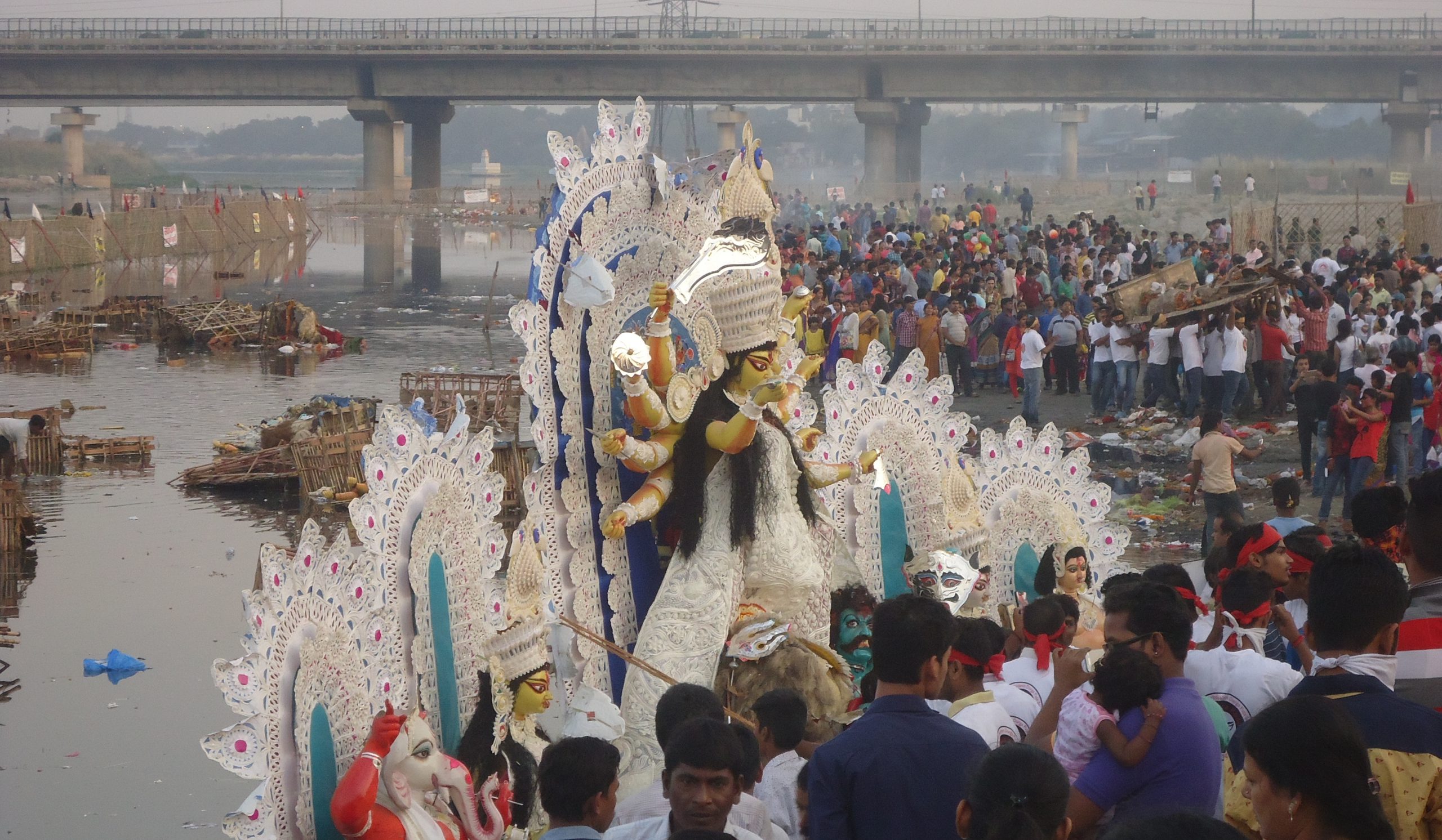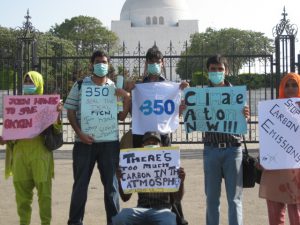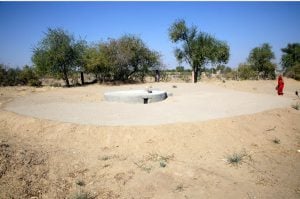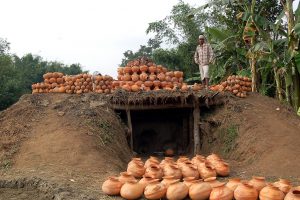The Delhi government last week began a daily aarti, a traditional Hindu ritual, to worship the Yamuna and encourage people to get involved in cleaning up the river reduced to a sewage drain passing through the Indian capital. But the state’s own pollution control board has failed to keep pace with the ‘clean Yamuna’ mission.
The river, like many others in India, is revered and is the centre of many festivals – be it Durga Puja where thousands gathered on the banks of the Yamuna to immerse idols of the goddess of power last month, or more recently the Chhath festival that saw the devout offer salutations to the sun god.

Disturbing images of women praying in clouds of white foam that was actually industrial waste was another rude reminder that the river — far from the pristine waters held to be sacred by so many — is actually a toxic, polluted stream.
Though Chhath was celebrated just this week, it has been nearly three weeks since Durga Puja and the Delhi Pollution Control Committee (DPCC) is still unable to share data on pollutants in the river after the idols were immersed. Instead, those seeking information that should be made public as a matter of routine are being given a bureaucratic runaround with many promises and no results.
If Chhath sees people make offerings of fruits and flowers, the five-day Durga Puja, an annual Bengali festival, culminates with the immersion. Each year, the festival leaves behind a trail of filth, with toxic substances from the idols and decorations leaching into the river. In order to make the idols look bright and attractive, makers often use non-environment-friendly paints that contain heavy metals like mercury, cadmium, arsenic and zinc that end up in the river.
This year, India’s green court, the National Green Tribunal (NGT), permitted the immersion of only those idols that were made of biodegradable materials like clay and painted with natural colours. It banned the immersion of idols made of non-biodegradable substances like plaster of paris and plastic in the Yamuna.
It is estimated that as many as 1,000 idols were immersed in the Delhi region and most ended up in the Yamuna. The pivotal question of whether it was a greener festival this year with the judiciary stepping in remains unanswered since the government authorities have refused to divulge the information.
Delhi washing its hands off Yamuna pollution?
The Central Pollution Control Board (CPCB) when contacted passed the buck on to Delhi, which it said was the state pollution control committee and therefore responsible for monitoring the water quality of the river and pollution levels during Durga Puja. When thethirdpole.net contacted DPCC, it was told no inspection was done to see if the idols were made according to the rules. Officials said they relied mostly on the word of organisers.
Pressed for scientific data, DPCC’s acting member secretary Anil Kumar told thethirdpole.net team to get in touch with its senior scientist handling water pollution. The senior scientist, Dr Nandita Moitra, in turn confirmed that DPCC had monitored the river for three days during Durga Puja and the test results would take at least 10 days.
Ten days later, the story was pretty much the same. The senior scientist refused to entertain our request and said written permission from the member secretary was needed before data could be disclosed. That it was the member secretary himself who had directed us to him didn’t seem to matter.
So it was back to the member secretary who this time asked us to speak to Delhi’s environment secretary Ashwani Kumar for permission. Another round of offices ensued. And when thethirdpole.net finally managed to speak to Kumar, he gave a statement completely contradictory to what the member secretary had said.
According to Kumar, no tests were done on the river for three days specific to Durga Puja. “We can give you only old data as the matter is sub judice in the National Green Tribunal. We cannot release the data in public domain before we submit it in the court,” he said.
No legal basis
“This is no reason to not share the data. There is no legal basis to this. They need to share such data with public. As per the Right To Information (RTI) act as well, the government must reveal all data and information except those in secret files,” said environment lawyer Ritwick Dutta.
Manoj Misra, convener of the NOG Yamuna Jiye Abhiyaan (Let Yamuna Live) who had filed the petition in court that brought a ban on immersion of non eco-friendly idols in Yamuna, added, “This is a clear case where the left hand doesn’t know what the right hand is doing. You have a scientist saying they have monitored the river and then you have a bureaucrat who is saying no such thing has been done. You see, this is how they wash their hands off the matter.”
“And if the monitoring was indeed not done, then why was it not done? They should have done it when it is such a big issue,” Misra said.
Without information, there is no way of knowing whether the court’s ban was effective.
DPCC’s own website says that one of its main functions specified by the government under the Water, Air and Noise Pollution Act is to “disseminate information in respect of matters relating to water and air pollution and their prevention and control”. By not disseminating figures on water pollution, the body has gone against its own mandate.
Durga Puja impact elsewhere
A 2014 research paper by researchers in the West Bengal capital Kolkata, where Durga Puja is celebrated with great gusto, found significant changes in water during and after immersions in the Ganga and various wetlands.
“The floating materials released through idols in the river and lake after decomposition results in eutrophication, increase in acidity and heavy metal concentration. Heavy metal pollution caused by idol immersion can damage the ecosystem as it kills fishes, damages plants, blocks the natural flow of the water, causing stagnation,” the report said.
Visible proof
The Yamuna, a vital lifeline for Delhi, could be witnessing similar effects.
At Shyam Ghat, a designated bank of the Yamuna where idols from north and west Delhi were immersed, there was a strong stench of sewage from the river. The banks and the river itself were choked with idols, rotting flowers, pieces of cloth, bamboo and other debris. No official was seen patrolling the area to check littering.
As the idols were immersed amidst holy chants, the dead Yamuna was left on its own to tackle the mess. It must have put enormous pressure on a river that hardly has any oxygen to decompose floating and dissolved organic matter.
Environment Secretary Ashwani Kumar insisted that “no idol immersion took place in Yamuna”. He said authorities had put bamboo poles in the river at nine spots to restrict the area under immersion and check spread of water pollution.
“These bamboo structures in the river cannot stop the flow of toxic pollutants and dissolved substances. That will only stop the solid material. And if they are saying they didn’t test the water quality, they are not doing it scientifically and it is not helping the cause,” retorted Thakkar.
Ideal immersion
Some people did put their best green foot forward.
“Those who went into the Yamuna for the immersion were complaining that the water was so dirty that they started getting rashes,” said D.P. Sarkar, a medical doctor and head of a Durga Puja committee in west Delhi’s Rohini locality. “We used only natural clay idol mounted on hay and wood. For polishing and colours, natural pigments containing tamarind were used.”
In south Delhi’s Chittaranjan Park, the idol was made completely of biodegradable materials and immersed in a compost pit at the venue of the event itself. “We filled the pit with water and immersed it there and the clay dissolved overnight. The next day we took out all the bamboo and other recyclable material and sent it to the idol maker so that he can reuse it next year,“ said Amit Roy, one of the organisers.








